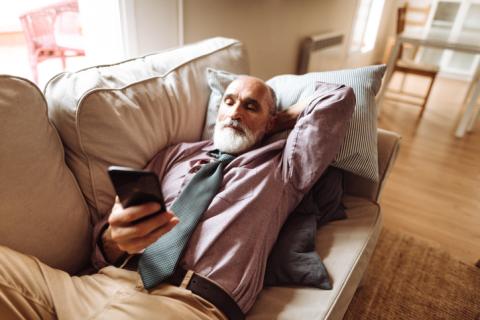Are Your Devices Making You Lazy?
By now, most of us know that getting enough exercise is vital for good health and optimal aging. More people today are at least making an effort, setting aside time several times a week to get some physical activity—a minimum of 30 minutes a day of moderate-intensity exercise is a good rule of thumb for most of us.
Recent research also shows that if we head out for a regular walk or to the gym even every day, yet spend the rest of our time sitting on the couch or at our desk, we are still harming our health. Prolonged sitting is linked with the risk of heart disease, obesity, cancer, diabetes and almost every chronic health condition. People of every age are encouraged to break up their days with a bit of exercise here and there, in addition to their regular workout.
Yet the Centers for Disease Control and Prevention (CDC) recently noted that most Americans of every age fail to get even the minimum recommended amount of physical activity. When asked why this is, many people have one answer: “I just don’t have time!”
But do they? The study, which was conducted by the RAND Corporation, found that, in fact, Americans average more than five hours of free time each day. “There is a general perception among the public and even public health professionals that a lack of leisure time is a major reason that Americans do not get enough physical activity,” said study author Dr. Deborah Cohen. “But we found no evidence for those beliefs.”
Dr. Cohen and her team were careful about what they classified as “free time.” Work hours and commuting don’t count, of course. But neither do playing with the kids, taking a shower, caring for an older loved one, cleaning the house or grocery shopping. “Free time” is defined as pure leisure hours — a person’s “me time.”
So instead of taking part in physical activity, what are we doing with our free time? Short answer, we’re texting, playing video games, and binge-watching TV shows. “Americans spend most of that time looking at screens (televisions, phones or other devices),” Dr. Cohen reports.
Another study, this one from Washington University School of Medicine in St. Louis, came to a similar conclusion. And here’s an interesting insight: though the stereotype is of a young person spending hours in front of a glowing screen, in fact older adults spend the greatest percentage of their free time watching TV or videos.
“We want to raise awareness about this issue on multiple levels — from individuals and families to schools, employers and elected officials,” said study author Dr. Yin Cao. “We can look at trends over time and see whether different interventions or public health initiatives are effective in reducing the time spent sitting and nudging people toward more active behaviors.”
On the individual level, what can we do to turn this trend around in our own lives? Every little bit counts.
- If you spend hours playing computer games, check out active games instead.
- Instead of watching TV or videos on the couch, put a TV in front of your treadmill.
- Skip the coffee shop, wine bar or your own couch when catching up with the latest gossip with your friend. Go for a walk instead.
- Listen to a podcast, or a playlist of your favorite music while you’re working out.
Ask your doctor to recommend a routine of physical activities that’s right for your age, health condition and abilities. There are plenty of senior fitness opportunities in your community. Go with a friend — or make new friends! It will most likely be a lot more rewarding than socializing on Facebook.
